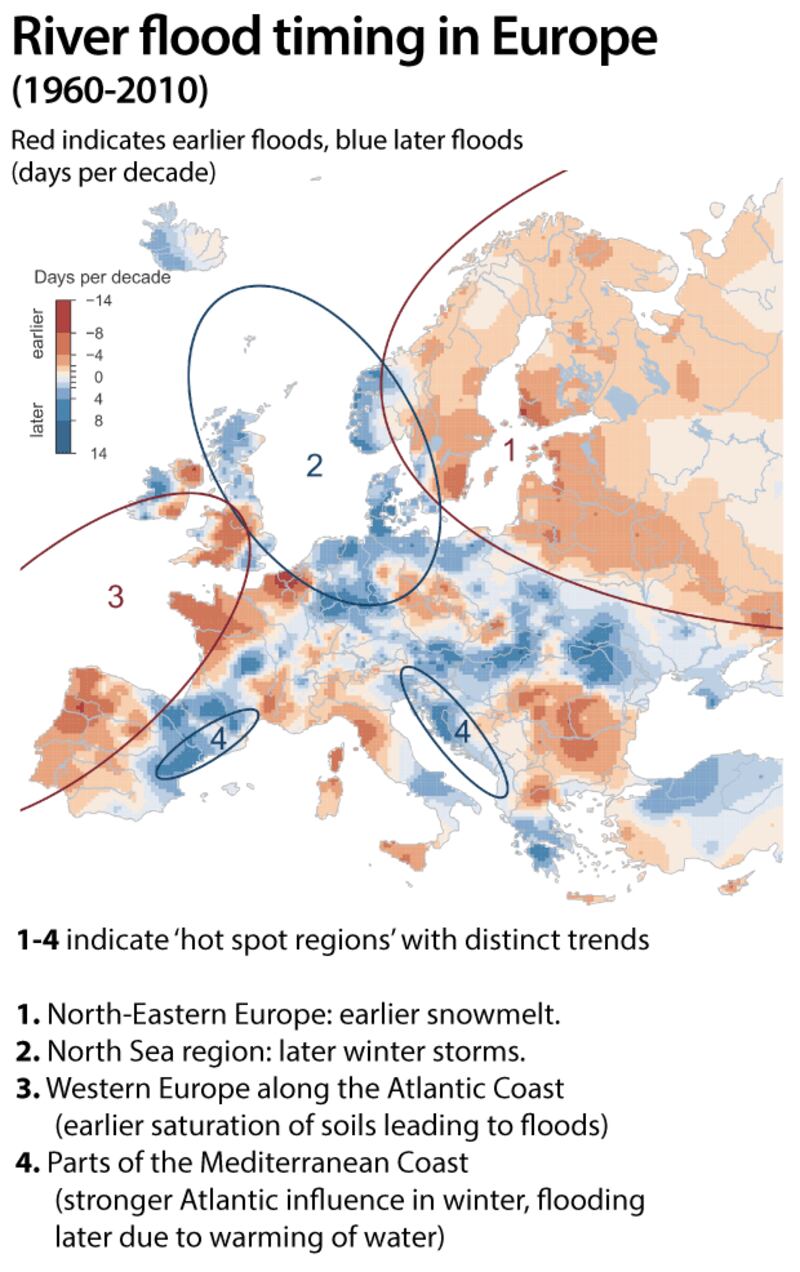The way floods are arising across Europe, including Ireland, is changing dramatically due to climate change, and it is mainly to do with their timing; some are occurring earlier in the year; others later.
The findings will necessitate changes to how major floods are managed, improved monitoring of water levels and better alert systems.
This has emerged from a study of more than 4,000 river points in 38 countries andit is the first time a clear picture has emerged on a whole-of-continent basis. Timing varies depending on location, but four “hotspots” have been identified, where the new timings of floods are particularly clear; one of which covers much of Ireland.

The definite linkage between climate change and floods across Europe has been identified using "a river flow dataset of unparalleled scale and diversity", according to Dr Conor Murphy of Maynooth University. He is one of 30 European scientists involved in the research which covers a 50-year period up to 2010. Their findings are published in the latest issue of the journal Science.
In north east Europe, notably Sweden, Finland and the Baltic states, floods are occurring a month earlier than in the 1960s and 1970s due to snowmelt caused by “human-induced” global warming.
In Ireland, and neighbouring parts of north-west Europe, floods are occurring later in the year. They are coinciding with later winter storms, which may be linked to a variation in an atmospheric pressure gradient over the Atlantic between the Equator and the North Pole – known as the North Atlantic Oscillation.
Natural variability
This may be caused by global warming, although natural variability in this changed weather pattern is also an important factor over the time period studied, explained Dr Murphy, a researcher with the Irish Climate Analysis and Research Units at Maynooth.
In Ireland’s case, a more complex picture emerges. Floods occur up to two weeks later in western Ireland (as well as northern Britain, coastal Scandinavia and northern Germany) than they did 20 years ago. Flooding on the east coast of Ireland and parts of southern England is occurring earlier in Autumn because soils in these regions are becoming saturated sooner due to wetter autumns and summers, he added.
The study warns that if current trends in the timing of floods continue “considerable economic and environmental consequences may arise”. It states that catchments around the North Sea, for example, may see reduced agricultural productivity due to softer ground, higher soil compaction, enhanced erosion and direct crop damage.
With earlier spring flooding occurring in Northern Europe, replenishment of reservoirs may not happen as previously anticipated with substantial reduction in water supply availability, irrigation and hydropower generation, it warns.
In parts of the Mediterranean coast, flood events take place later in the season and this aligns with observed warming of the Mediterranean sea.
Flood timing is “more sensitive to climate-driven changes than other aspects of flooding, such as the magnitude of peak flows”, the team led by Prof Günter Blöschl of Vienna University of Technology concludes.
Little evidence
Dr Murphy’s team has taken part in a separate international collaboration which found little evidence for increases in flood magnitude across Europe and North America, that may be attributable to climate change. The latest study did not evaluate the frequency of flooding.
He added: “The timing of floods throughout Europe over many years gives us a very sensitive tool for deciphering their causes. This newly created dataset means that we are now able to identify connections that previously were purely speculative.”
The trends highlighted in the study, in effect shows "the flooding season is extended" in Ireland. While a delay of weeks, for example, might seem insignificant, it had implications for how local authorities respond and the resources they will need to deal with floods, Dr Murphy told The Irish Times.
The changes in timings also underlined the need for adequate flood warming systems, he said. Such was the scale of flood damage in December 2015, the Office of Public Works and Met Éireann were asked by the Government to oversee the adoption of new alert systems suited to the Irish environment. Their development was an ongoing process, he confirmed.
With soil moisture levels reaching their maximum earlier in the year in more recent periods leading to widespread flooding in parts of Ireland and Britain, co-author Dr Shaun Harrigan of UK Centre for Ecology and Hydrology said it "highlights the need to consider the role of changing soil moisture dynamics, as well as extreme precipitation, in understanding how floods might change in future".














